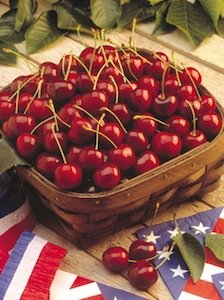Cherries are among the specialty crops that should see export opportunities from new trade agreement.
March 15 marks the effective date of the U.S.-Korea free trade agreement, and for sweet cherries, the 24 percent tariff elimination should translate into immediate positive results for the 2012 cherry season. Two other pending U.S. free trade agreements—one with Colombia and the other with Panama—are in the final stages of implementation but do not have effective target dates set yet. However, tree fruit industry officials are hopeful the two agreements will be effective in time for tree fruit tariff rates to be dropped before next season.
B.J. Thurlby, president of Northwest Cherry Growers, is excited about the prospect for additional export sales into Korea this season. Without the 24 percent duty, the landed cost for cherries will be less for importers and Korean retailers, he says. Thurlby is hopeful the tariff reduction will be passed on to Korean consumers in the form of lower retail prices. “As Costco is the largest direct retail importer, and one of the largest importers to Korea, we expect Costco to keep their margins the same and the consumer will see the savings. This could drive the need for other retail chains to pass the savings on to the consumer.”
“The lower retail prices should create insistent demands from the Korean consumers,” said Keith Hu, international marketing director for Northwest Cherry Growers. Hu expects a record volume of Northwest cherries to be exported to Korea in 2012; last year, Northwest producers exported nearly 352,000 boxes of cherries to Korea.
The timing of the tariff elimination in Korea is nearly perfect, adds Mark Powers, vice president of the Northwest Horticultural Council. It’s well in advance of this year’s cherry season and gives industry time to gear up for additional sales. “Korea is a significant market, and the 24 percent tariff elimination is real money and will make a difference, increasing sales to that market.”
But the promise of export opportunities from the eventual Korean tariff elimination for U.S. apples and pears tariffs is empty. Phytosanitary issues of primarily codling moth and postharvest decay diseases, and fierce protectionism, have shut out pome fruit from the United States and other countries, with little hope for progress in the near future. The new U.S. agreement with Korea does not include resolution to the phytosanitary issues and it’s impossible to predict when the United States might negotiate access to Korea for apples and pears, Powers said.
“It’s not just political roadblocks,” he said, adding that the plant health issues raised by the Koreans are legitimate. “At present, there’s no political will to negotiate a technical work plan that would address legitimate plant health concerns and allow commercial trade to proceed.”
Colombia and Panama
Though all three free trade agreements with Korea, Colombia, and Panama were signed by President Obama last October, Powers notes that it takes time for each country to perform a “legal scrub” of the documents, align existing regulations, and implement new ones, if needed. In addition, the U.S. government must confirm that Colombia and Panama have implemented changes dealing with issues like labor and banking that were part of the agreements.
Once the free trade agreements with Colombia and Panama enter into force, the 15 percent Colombian duty on apples, pears, and cherries, and Panama’s duty of 2, 5, and 1 percent, respectively, are scheduled for immediate elimination.
Exports on fire
Apple and pear exports have been strong this season to south and central American countries, even without the Colombia and Panama duty eliminations.
For apples, exports to Panama have increased more than 50 percent compared to last season, reports Washington Apple Commission’s Todd Fryhover. To date, Panama shipments are nearly 137,500 bushel cartons, a “fantastic” quantity, according to Fryhover. Colombian export numbers have been even more impressive—about 611,500 bushel cartons in 2011-2012 compared with last season’s 225,300. However, he notes that Washington shipments in 2010-2011 to Colombia were off greatly due to market disruption from the Chilean earthquake.
“Colombia is a key strategic market for Washington,” said Fryhover. “We expect to see stability and a level playing field with our competitors from the free trade agreements more than a large increase in shipments.”
Northwest pear exports to Colombia are up by nearly 50 percent compared with last year, said Kevin Moffitt of the Pear Bureau Northwest. Shipments to Panama are up by about 8 percent in comparison to last year.
Colombia and Panama have not been major export markets for Northwest cherries; approximately 3,500 boxes were shipped to the two countries in 2011. “However, the great results that the Washington Apple Commission is seeing with those economies could incent the cherry industry to take the risk of shipping more cherries there in 2012,” said Thurlby. “Certainly, the free trade agreements can only add to the opportunity to grow those two markets in the future.”
The Hort Council’s Powers said that U.S. trade officials are hopeful the trade agreements with Colombia and Panama will be worked out by summer and provide time for industry to make export plans for next season.




Leave A Comment